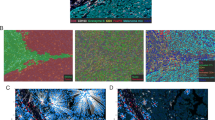Abstract
Purpose
Although relatively rare, uveal melanoma is the most common ocular tumor of adults. Up to half of uveal melanoma patients die of metastatic disease. CXCR4, a chemokine receptor, is a prognostic factor in cutaneous melanoma involved in angiogenesis and metastasis formation. The aim of this study was to evaluate the expression of CXCR4 in uveal melanoma.
Methods
CXCR4 was detected by immunohistochemistry in 44 samples of uveal melanoma. Staining was categorized into three semiquantitative classes based on the rate of stained (positive) tumor cells: absence of staining, <50% of cell (+) and >50% (++). Correlations between CXCR4 expression, data on patient and tumor features were studied by contingency tables and the χ2 test. Time-to-event curves were studied using the Kaplan–Meier method. Univariate analysis was performed using the log-rank test. Ninety-five percent confidence intervals (95% CI) of hazard ratios were also reported.
Results
Staining for CXCR4 protein was absent in 18 tumors (40.9%), present in <50% of cells in 19 (43.2%) and in >50% of cells in 7 (15.9%) tumors. CXCR4 expression correlated to the epithelioid-mixed cell type (P = 0.030). No statistically significant relation emerged between CXCR4 expression, largest tumor diameter (LTD) and extracellular matrix patterns as evaluated through histological patterns stained with periodic acid-Schiff (PAS). Events occurred in 2 out of 18 patients (11.1%) with negative tumors (2 deaths), in 3 out of 19 patients (15.8%) with <50% of positive tumor cells (2 deaths and 1 occurrence of metastases) and in 1 out of 7 patients (14.3%) with >50% of positive tumor cells (1 occurrence of metastases). The cell type (P = 0.0457) but not CXCR4 showed prognostic value at univariate analysis.
Conclusion
This study shows that CXCR4 is commonly expressed in uveal melanoma and correlates with cell type a well-established prognostic factor.


Similar content being viewed by others
References
Harbour JW (2003) Clinical overview of uveal melanoma: introduction to tumors of the eye. In: Albert DM, Polans A (eds) Ocular oncology. Marcel Dekker, New York, pp 1–18
Schmittel A, Bechrakis NE, Martus P, Mutlu D (2004) Independent prognostic factors or distant metastases and survival in patients with primary uveal melanoma. Eur J Cancer 16:2389–2389
Callender GR (1931) Malignant melanotic tumors of the eye: a study of histologic types in 111 cases. Trans Am Acad Ophthalmol Otolaryngol 36:131–142
Zimmerman LE, McLean IW, Foster WD (1978) Does enucleation of the eye containing a malignant melanoma prevent or accelerate the dissemination of tumour cells. Br J Ophthalmol 62:420–425
Zimmerman LE, McLean IW (1979) An evaluation of enucleation in the management of uveal melanomas. Am J Ophthalmol 87:741–760
McLean IW, Zimmerman LE, Foster WD (1979) Survival rates after enucleation of eyes with malignant melanoma. Am J Ophthalmol 88:794–797
Prescher G, Bornfeld N, Hirche H (1996) Prognostic implications of monosomy 3 in uveal melanoma. Lancet 347:1222–1225
Tschentscher F, Husing J, Holter T (2003) Tumor classification based on gene expression profiling shows that uveal melanomas with and without monosomy 3 represent two distinct entities. Cancer Res 63:2578–2584
Folberg R, Pe’er J, Gruman LM (1992) The morphologic characteristics of tumor blood vessels as a marker of tumor progression in primary human uveal melanoma: a matched case-control study. Hum Pathol 23:1298–1305
Onken MD, Worley LA, Ehlers JP, Harbour JW (2004) Gene expression profiling in uveal melanoma reveals two molecular classes and predicts metastatic death. Cancer Res 64:7205–7209
Murphy PM (2001) Chemokines and the molecular basis of cancer metastasis. N Engl J Med 345:833–835
Burger JA, Kipps TJ (2006) CXCR4: a key receptor in the crosstalk between tumor cells and their microenvironment. Blood 107:1761–1767
Robledo MM, Bartolome RA, Longo N (2001) Expression of functional chemokine receptors CXCR3 and CXCR4 on human melanoma cells. J Biol Chem 276:45098–45105
Kawada K, Sonoshita M, Sakashita H (2004) Pivotal role of CXCR3 in melanoma cell metastasis to lymph nodes. Cancer Res 64:4010–4017
Wiley HE, Gonzalez EB, Maki W (2001) Expression of CC chemokine receptor-7 and regional lymph node metastasis of B16 murine melanoma. J Natl Cancer Inst 93:1638–1643
Takeuchi H, Fujimoto A, Tanaka M (2004) CCL21 chemokine regulates chemokine receptor CCR7 bearing malignant melanoma cells. Clin Cancer Res 10:2351–2358
Muller A, Homey B, Soto H (2001) Involvement of chemokine receptors in breast cancer metastasis. Nature 410:50–56
Scala S, Giuliano P, Ascierto PA (2006) Human melanoma metastases express functional CXCR4. Clin Cancer Res 12:2427–2433
Scala S, Ottaiano A, Ascierto PA (2005) Expression of CXCR4 predicts poor prognosis in patients with malignant melanoma. Clin Cancer Res 11:1835–1841
Murakami T, Maki W, Cardones AR (2002) Expression of CXC chemokine receptor-4 enhances the pulmonary metastatic potential of murine B16 melanoma cells. Cancer Res 62:7328–7334
Moulin AP, Yan P, Rimoldi D (2006) Expression of chemokine receptors in uveal melanoma. Annual meeting of the association for research in vision and ophthalmology, 2006, abstract no. 2215/B958
Acknowledgments
This study was supported by a grant from AIRC (Associazione Italiana per la Ricerca sul Cancro).
Author information
Authors and Affiliations
Corresponding author
Rights and permissions
About this article
Cite this article
Scala, S., Ieranò, C., Ottaiano, A. et al. CXC chemokine receptor 4 is expressed in uveal malignant melanoma and correlates with the epithelioid-mixed cell type. Cancer Immunol Immunother 56, 1589–1595 (2007). https://doi.org/10.1007/s00262-007-0303-6
Received:
Accepted:
Published:
Issue Date:
DOI: https://doi.org/10.1007/s00262-007-0303-6




